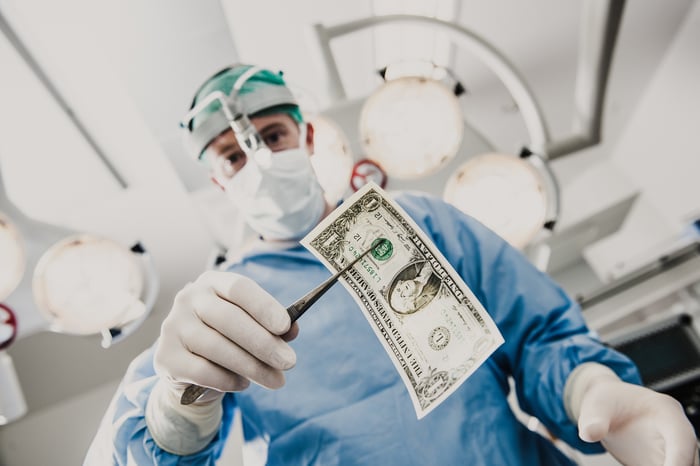For the past decade, the FAANG stocks have been unstoppable. By FAANG, I'm referring to:
- Amazon
- Apple
- Netflix
- Google, which is a subsidiary of Alphabet

Image source: Getty Images.
Over the trailing 10-year period, the benchmark S&P 500 is up 200%, while the FAANG stocks have delivered an average return of 1,263%. Note that this includes Facebook's 591% return since its initial public offering in 2012.
FAANGs have been so popular because of their industry-specific domination and exceptional growth rates. But after more than a decade, even the FAANGs are maturing. As the U.S. and global economy transform in the wake of the coronavirus disease 2019 (COVID-19) pandemic, a new set of superstar stocks appears ready to step into the spotlight.
Investors, say goodbye to the FAANG stocks and hello to TIPS.

Image source: Getty Images.
The T stands for Teladoc Health
Over the next decade, we're going to witness an incredible push toward precision medicine. Rather than leaning on one-size-fits-all treatments, we'll see individual treatment plans take over. Lower costs and patient/physician convenience will dominate the conversation. These trends suggest that telemedicine giant Teladoc Health (NYSE:TDOC) has truly unlimited upside.
Many folks will point out that COVID-19 has been a big catalyst -- and that's 100% true. Total virtual visits more than tripled during the second quarter, with physicians and hospitals wanting to keep at-risk patients out of their offices as much as possible. But this growth story has been evolving for years. With Teladoc on track for $1 billion in sales in 2020 (a 75% compound annual growth rate since 2013), and insurers enjoying the lower cost burden associated with virtual visits, Teladoc's game is still in the very early innings.
Its growth story is about to get even more exciting. Teladoc is in the process of acquiring applied health signals company Livongo Health (NASDAQ:LVGO) for $18.5 billion in a cash-and-stock deal. Livongo's solutions rely on artificial intelligence and send its members tips and nudges that lead to lasting behavioral changes. Livongo has doubled or nearly doubled its diabetes member count in each of the past three years.
When Teladoc and Livongo become a single company, it could well have tenfold upside over the next decade.

Image source: Getty Images.
The I stands for Intuitive Surgical
To really drive home the importance of precision medicine, I'm doubling down on exposure to medical-device innovation with Intuitive Surgical (NASDAQ:ISRG), the developer of the da Vinci surgical system that aids a variety of soft tissue surgeries.
Why Intuitive Surgical? To begin with, it has what looks to be an insurmountable market share advantage in surgical-assisted systems. As of the end of June, Intuitive Surgical had installed 5,764 of its da Vinci systems worldwide -- far more than all of its competitors combined. This has allowed the company to build rapport with hospitals and surgical centers. It also doesn't hurt that these machines cost anywhere from $0.5 million to $2.5 million, making it unlikely that its clients will ever switch to a competitor.
This is also a company built to generate juicier operating margins over time. During the 2000s, the da Vinci system made up the lion's share of Intuitive Surgical's sales. Unfortunately, the margins on these highly intricate machines aren't that great, but as the installed base of da Vinci systems has grown, so has the percentage of sales tied to servicing and procedure-specific instruments. These are much higher-margin sales segments poised to grow throughout the 2020s.
There's plenty of opportunity for Intuitive Surgical to grow its share in various soft tissue surgical indications. The company offers double-digit growth potential for a long time to come.

Image source: Pinterest.
The P stands for Pinterest
In the years to come, popular social media and e-commerce sites are going to have a field day. That's why it's smart for investors to buy into Pinterest (NYSE:PINS), which offers exceptional growth potential on both fronts.
Though it's difficult to maintain user growth over a long period of time in the social media space, this hasn't phased Pinterest. In the June-ended quarter, it tallied 416 million monthly active users (MAU), which is up a cool 116 million MAU from the year-ago period.
While COVID-19 keeping people in their homes has certainly encouraged increased screen time, the really noteworthy statistic is that Pinterest has seen more than 90% of its MAU growth come from international markets. On the downside, international users offer much lower revenue per user than MAUs in the United States. However, Pinterest more than doubled its average revenue per international user in 2019. It's these overseas users that offer Pinterest sustainable double-digit growth potential.
There's also the company's push into e-commerce. Since Pinterest provides a platform for its users to share what products and interests matter to them, it makes sense to connect small businesses to these presumably motivated shoppers. The company is focused on user convenience and maintaining engagement. It could well become a popular e-commerce destination in the years to come.

Image source: Square.
The S stands for Square
Finally, investors will want to own preeminent fintech stock Square (NYSE:SQ) to take advantage of ongoing innovation in the payment space.
You're probably familiar with or have used one of Square's point-of-sale devices at some point. Between 2012 and 2019, the gross payment volume on Square's seller ecosystem surged from $6.5 billion to $106.2 billion. That's a compound annual growth rate of 49%.
Traditionally, Square's point-of-sale devices, loans, and analytic tools have been targeted at small businesses. But what's interesting is just how many medium-sized and large businesses have been using its seller ecosystem of late. Through the first two quarters of 2020, 52% of the GPV came from businesses with an annualized GPV of at least $125,000. Since the company's seller ecosystem is based on merchant fees, attracting bigger businesses can lead to significant sales revenue.
Yet what's really exciting Wall Street and investors about Square is the company's peer-to-peer payment platform Cash App. User growth has been phenomenal, with MAUs increasing from 7 million at the end of 2017 to 30 million by June 2020. Approximately 7 million of these MAUs are also using Cash Card, a traditional debit card that links to a users' Cash App balance.
Cash App represents the evolution of financial payments, and it gives Square so many ways to make money. Cash App generates merchant fees, transfers fees, and even revenue from investments and bitcoin exchange. Cash App gives Square genuine 10-bagger potential.
Forget FAANG, folks, and say hello to TIPS.
The Link LonkOctober 08, 2020 at 05:06PM
https://www.fool.com/investing/2020/10/08/forget-the-faang-stocks-and-buy-tips-instead/
Forget the FAANG Stocks and Buy "TIPS" Instead - Motley Fool
https://news.google.com/search?q=forget&hl=en-US&gl=US&ceid=US:en

No comments:
Post a Comment